The X Button
Jumping and Shooting
by Todd Ciolek,

It's time once again to examine some mild, inconsequential censorship in the field of video game cover art. Under fire this week is that enemy of all civilized culture: the human thigh.
Tactics Ogre: Let Us Cling Together for the PSP is an excellent remake of the semi-classic 16-bit strategy-RPG, and I should really have reviewed it by now. In bringing the game to North America, Square Enix altered the cover.
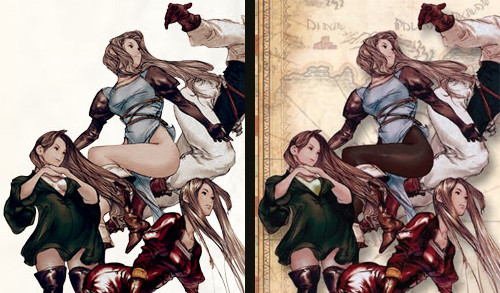
Olivya, a priestess and the love interest of main character Denam, was apparently showing a bit too much leg in the original artwork. So Square Enix gave her tights instead of wicked, sinful bare flesh. There are other revealed thighs on the Tactics Ogre cover, including those of Olivya's sister Sherri, but only Olivya's were covered.
Tecmo Koei made a similar change to the cover of Dead or Alive Dimensions, as Kasumi's clothing was adjusted ever so slightly to cover a patch of skin shown on the Japanese cover.
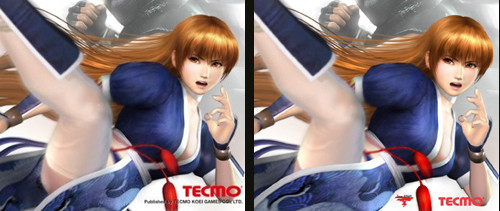
After all, this is a game for a Nintendo system, not one of those licentious Microsoft consoles peddled in ads about high-kicking women.
Meanwhile, Atlus found a solution regarding the provocative cover for the U.S. version of Catherine, an adventure game with surreal and sexual overtones. Most retailers will see a PlayStation 3 cover that recreates the Japanese one. More sensitive ones (i.e. Wal-Mart) will get a less risqué close-up.

The same goes for the Xbox 360 version, which didn't have particularly ribald cover art in the first place.
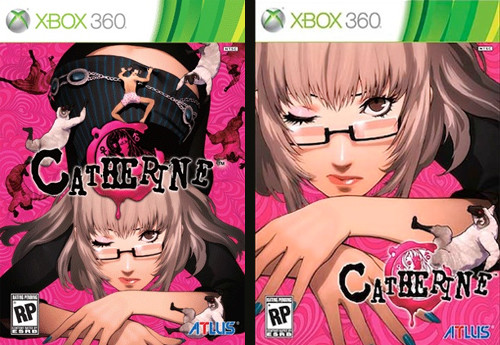
Changes like these put forth an important question. The game industry's grasp of sexuality is often embarrassing, but isn't it just as silly to obscure minor, harmless displays of it, particularly when those displays reflect the game at hand? All I know is this: compared to other things discussed this week, exposed thighs shouldn't bother anyone.
NEWS
SOUL CALIBUR V JUMPS AHEAD
Soul Calibur needs a shakeup. The series remains popular, but it's grown less and less important since 2003's Soul Calibur II. It's a victim of its own scope, stacking new characters and story concepts on top of each other until the whole thing threatens to collapse in a mess of apathy. Director Daishi Odashima is changing things with Soul Calibur V, at least as far as the time frame goes. It's set 17 years after the events of Soul Calibur IV, and it has a new main character: Patroklos, the son of Soul series mainstay Sophitia. Like his mother, Patroklos arms himself with a sword and shield. Unlike his mother, Patroklos wears sensible clothing into battle.

Odashima isn't about to ignore Soul Calibur's history, and he debuted new artwork of one returning character: Siegfried, the German knight closely tied to the cursed Soul Edge. Perhaps that's why he doesn't look a day older than he did in Soul Calibur IV.
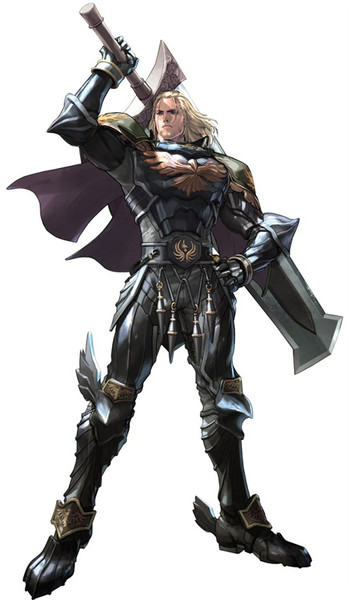
It remains to be seen just how a 17-year leap will affect the other characters, or if they'll return at all. Odashima reportedly wanted to call the game Soul Edge 2, hearkening back to the original game in the series, so perhaps there'll be a drastic culling of the roster. Smart money that younger fighters like Talim, Kilik, Amy, Yunsung, and possibly Seong Mi-Na will return, as will seemingly ageless combatants like Astaroth, Ivy, and Raphael. I would like to see Hilde from Soul Calibur IV return. I'd also like to see no guest fighters at all. Not Kratos, not Darth Vader, and not some generic Todd McFarlane action figure. And the game should come with a free fruit roll-up when it arrives in 2012.
DEVIL SURVIVOR 2 HOLDS THE FORT ON THE DS
Some clarification is in order: Devil Survivor Overclocked is an enhanced version of the original Devil Survivor, and it's headed for the 3DS. Devil Survivor 2 is the sequel to the first game, and it's coming to the reliable, vanilla-flavored DS.
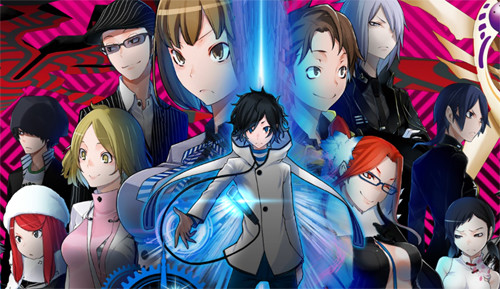
Featuring a largely new cast of characters, Devil Survivor 2 finds modern Japan in the grip of demonic invasion, as is the case with many a Shin Megami Tensei game. This threat prompts 13 humans to make a deal with an equally demonic force in exchange for ominous powers. The apparent lead is a high-school boy named by the player, and he's joined by his childhood friend Daichi and class brainiac Io. The 13-character roster is further staffed by members of the slightly ominous organization called GIPS, which includes white-haired teenage leader Yamato, stodgy Makoto, silent scientist Fumi and kindly medical researcher Otome. The rest of the characters will be revealed in due time, and manga author Suzuhito Yasuda is designing the main cast, sure to disappoint those who found his work on the original painfully generic. The monsters are the work of another manga artist: Mohiro Kitoh. Yes, the same Mohiro Kitoh who makes cute and horrifying comics like Shadow Star and Bokurano. He's perfectly at home in the Shin Megami Tensei world.
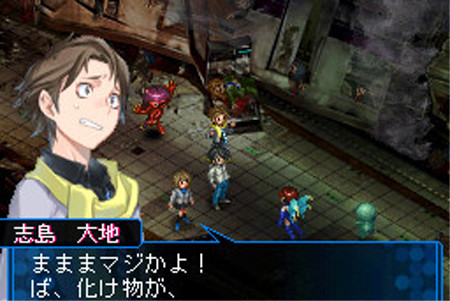
Aside from the expanded character lineup, Devil Survivor 2 offers several different cities to explore. The strategy-RPG battle system is much like the original game's combat, though the ranks of usable monsters are once again expanded. Atlus producers also emphasize the game's replay potential, as choices throughout the game lead to different storylines and endings. Devil Survivor 2 is out July 28 in Japan, and a domestic release is likely even with the industry's rapidly shrinking support for the original DS.
KAGURA: PORTRAIT OF GIRLS IS NOT A JOKE
I avoided writing about Kagura: Portrait of Girls for a few weeks. It's the sort of game that should be left on its own for a while, just in case it turns out to be an elaborate prank. And it may as well be. Webcomics and pundits and forums have joked about suggestive 3DS games ever since Dead or Alive Dimensions was announced. But while others laughed, Marvelous producer Kenichiro Takaki actually did something about it. He started work on Kagura: Portrait of the Girls, a 3DS brawler that bluntly capitalizes on its characters' three-dimensional bustlines. No joke, we assure you.
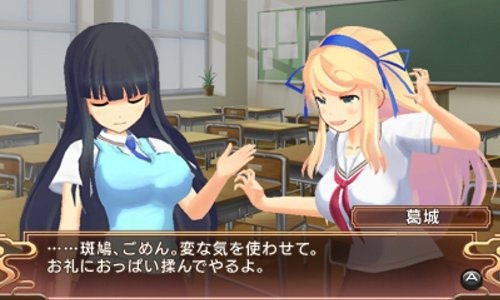
This is familiar ground for Takaki, as he oversaw the Marvelous-made Ikki Tousen action games, in which female characters lost clothing in battle. Set at a modern-day school, Kagura follows five ninja girls of varying personalities and measurements, from eager lead Asuka to predatory blonde Katsuragi, in martial-arts battles and mundane conversations. The heroines all take visible damage to their attire when fighting (of course), and they can wear all sorts of suggestive outfits (of course). Marvelous hasn't talked up Kagura's gameplay much (OF COURSE), but it's described as a side-scrolling action title. Perhaps it takes cues from Vanillaware's Muramasa: The Demon Blade, which Marvelous published in Japan.

Side-scroller or not, Kagura: Portrait of Girls is classified as a “Bursting Breasts Hyper-Battle” by Marvelous. That says everything you need to know about the game, which seems so far down modern anime's rabbit hole that there's no point in criticizing it. We can only note Takaki's unguarded honesty and wonder if any U.S. game publisher is mad enough to release it here. Marvelous brings out the Japanese version this summer.
IN BRIEF: THE PSN RETURNS, SUPER ROBOT TAISEN OG HITS PS3
The PlayStation Network is now up and running again, following three weeks of hacker-induced downtime. Well, it's running in the sense that you can at least download a system update and change your password. Sony also announced just how they're making it up to everyone: once the PSN is fully returned to life, users get their choice of two free games for each Sony system they own. PlayStation 3 owners can choose from Infamous, LittleBigPlanet, Wipeout HD + Fury, Dead Nation, and Super Stardust HD. The PSP crowd can pick two freebies from ModNation Racers, Killzone Liberation, Pursuit Force, and the PSP version of LittleBigPlanet. Other Sony offers include a free 30-day PlayStation Plus membership, 100 free items for PlayStation Home users, and a to-be-announced collection of free movie rentals. The offer's good for sixty days after the PSN revives.
The Super Robot Taisen Original Generation games are a perfect example of just how popular Super Robot Taisen is. Normally the series mixes in mecha from many different popular anime series, with a few original characters thrown into the mix. However, this formula expanded so much that the Original Generation games arose on the Game Boy Advance just to chronicle only the cast members made especially for Super Robot Taisen. And now there's word of The 2nd Super Robot Taisen arriving on the PlayStation 3. It's apparently a sequel to the PlayStation 2's Original Generation, itself remake of the two Game Boy Advance titles. This should be of special interest to Western fans. Licensing issues have long prevented North American companies from releasing anime-affiliated Super Robot Taisen games, but Atlus brought out the two Original Generation titles for the Game Boy Advance.
DOWNLOAD ROUNDUP: MAY
NIN2-JUMP Nin2-Jump is not the sort of game normally seen from Cave, a developer heavily versed in shooters. The company's first original Xbox Live game, Nin2-Jump is a platformer presented as a shadow play. Main character Nin-Ja and his surroundings are dark cutouts propped up by near-invisible lines, and all of them move before a silhouetted audience of excitable children. That aside, Nin2-Jump has the same basic idea as Super Meat Boy and other recent platformers: survive a series of short but increasingly tough levels. With only a scarf and some jumping ability, Nin-Ja starts off in basic circumstances as he navigates levels and collects scrolls. Then he gets a grappling chain, and the game gets a lot more interesting. Useful as both a weapon and a climbing tool, the chain lets Nin-Ja reach new heights and play around with the game's interesting physics. While it progresses like a typical run-and-jump affair, Nin-Ja's movements feel just a touch slower, reflecting the whole shadow-puppet nature of the game. Time is perhaps his worst enemy, as a rather tenacious demon emerges if Nin-Ja can't finish a level quickly, recalling the days of Bubble Bobble and Baron Von Blubba. Fortunately, the game's not a straight test of timing. Boss battles cap each row of levels, and there's even an amusing tone to the storyline. While Nin2-Jump may look stiff, it's an enjoyable little game and an important step outside of Cave's favored genre. Now they can make Princess Debut 2. |
STRANIA: THE STELLA MACHINA G.rev labored long and hard in the shooter scene's background. They collaborated with Treasure on the well-regarded Ikaruga, but their solo creations have either stayed in Japan (Border Down) or fared poorly in North America (Senko no Ronde). That may be why G.rev is delivering their newest shooter on Xbox Live, where it can be easily sampled and understood. And unlike some modern shooters (see the one below), Strania doesn't nestle in a fantasy land of shrieking preteen magicians and Skittle-colored bullets. It's rooted in the aesthetics of classic shooters, letting players fight a robot-heavy war in skies and space. The player's mecha can carry three weapons and use two at any time, cycling through them when the situation calls for it. New armaments are dropped by allies and destroyed enemies, Einhander-style, and they give players a catalog of standard shooter gear: lasers, vulcan guns, missiles, inverted-direction shots, bouncing bullets, and swords. G.rev's experience in the genre is widely evident in Strania, as it all looks slick and has the quickly satisfying design of a good arcade game. Even if levels aren't particularly long, they're tough, and G.rev doesn't let players cheat their way to the end by milking credits. Strania lacks the bullet-manipulating gimmicks of Ikaruga (or Trouble Witches Neo, for that matter), but it's still an accomplished shooter that resembles some of the best in its field. |
TROUBLE WITCHES NEO Here I am torn between my hatred of hyper-cutesy “moe” anime and my love of traditional 2-D shooters with terrible voice acting. Trouble Witches Neo has all of these things. Originally an indie game by Studio Siesta, this shooter sends an assortment of young witches and their familiars through side-scrolling stages. Each has the standard magical forward-firing shot, but there's a unique method of dealing with enemies and their screen-blanketing green bullets. Using a limited energy meter, the witches can project magic circles that slow down bullets. If the foes that fired said bullets are destroyed, the circle coverts the shots into money and points. It transforms a fairly standard bullet-hell shooter into a unique challenge, requiring players to dodge shots, destroy enemies, and manage their magic circles all at once. Extra-powerful weapons are also available from a floating pumpkin store, and witches can stock three of them at a time. Too bad it's not particularly long, unless you insist on one-crediting the game or going through with every character. As a game from indie origins, Trouble Witches Neo is fairly impressive in appearances: the Xbox Live Arcade version is now HD, and all of the character art was redrawn. It's still a parade of gigantic-eyed anime girls, each with their own clichéd, demographic-aimed foibles, and the game occasionally veers into the particularly creepy vein of “moe” (poke the item shop's clerk for an example). So it's perhaps for the best that everything's ferried along by grandly amateurish voice acting, with the cast stumbling everywhere in attempts to sound cute, wry, or humorous. It's not quite as amazing as, say, Castle Shikigami 2 (Active Gaming Media's translated text is relatively coherent), but nearly every spoken line is a cringe-inducing marvel. Of course, the voices can be switched to the original Japanese. I will never do that. |
NEXT WEEK'S RELEASES
DEAD OR ALIVE DIMENSIONS In the wake of Kagura: Portrait of Girls, the women of Dead or Alive now resemble the nuns of a particularly austere convent. Then again, the Dead or Alive series was always more conventional in its shameless T&A, closer to a beer commercial or a hot-rod magazine instead of a lurid anime comedy. It's much the same way in its approach to fighting games, using an aggressive, cinematic style that casual players can easily grasp. This leads some to criticize the games as facile, back-and-forth matches devoid of the intricacies of Virtua Fighter, but Dead or Alive fans can always snarkily point out that Virtua Fighter's had trouble getting its latest installments released here. Dimensions features 25 characters from various prior games, and it boasts a story-intensive Chronicle Mode for those who actually remember any of the endings in Dead or Alive 4. For those who don't care about plot, there's the standard serving of survival modes and training levels, and the lower 3DS screen lets players input special moves with simple taps. The game also runs in stereoscopic pseudo-3D, but that can be turned off to run everything at a higher frame rate. And there's still plenty of what the North American cover doesn't show. |
discuss this in the forum (26 posts) |
this article has been modified since it was originally posted; see change history
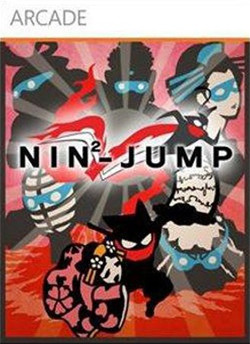 Developer: Cave
Developer: Cave Developer: G.Rev
Developer: G.Rev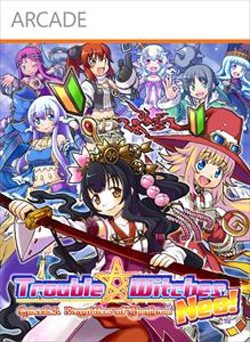 Developer: Studio Siesta
Developer: Studio Siesta Developer: Team Ninja
Developer: Team Ninja